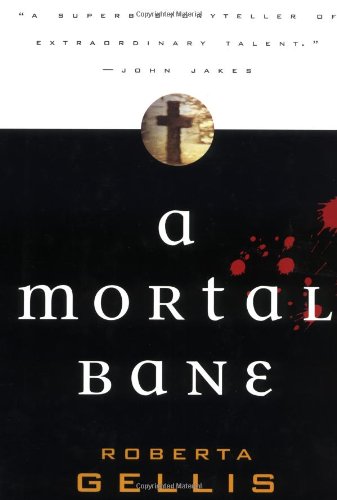A Mortal Bane
Gellis, acclaimed author of The Roselynde Chronicles, shifts gears dramatically in this, her first medieval mystery. We are introduced to Southwark and London in 1139, caught in the tangle of the intrigues and conflicts precipitated by the civil war between King Stephen and his cousin, the Empress Mathilda, who many hold to be the legitimate queen of England.
We are introduced to our heroine, Magdalene la Batarde, the madam of the Old Priory Guesthouse in Southwark – not an ordinary “stew,” mind you, but the highest class brothel perhaps in all of England, with the most desirable clientele. We come to learn that Magdalene (not her real name) is likely of high birth (although the circumstances are not revealed), but that she has “fallen” after being involved in some terrible crime, perhaps murder (although never discussed in any depth). Fortunately for Magdalene, she is both a skilled embroideress and sufficiently flexible in her life choices to open a brothel with the assistance of the Bishop of Winchester, choosing as her whores three sensory-impaired women, two of whom are, naturally, skilled embroideresses as well. The third whore is visually impaired, so she isn’t expected to embroider.
No, I’m not kidding. Indeed, I initially thought, “This must be a spoof on the medieval mysteries I’ve come to know and love.” Unfortunately, Gellis was serious about this book.
A papal envoy is murdered immediately after visiting Magdalene’s stew. What he was carrying, where he has put the objects and who has murdered him is the focus of the mystery. To find the murderer and to shift blame away from the last people to see the envoy alive – the whores of Old Priory — the Bishop of Winchester appoints Sir Bellamy of Itchen (no, again, I’m not kidding). Naturally, Bell is instantly captivated by Magdalene. How he finds the murderer and whether he manages to bed Magdalene is, essentially, the balance of the action.
As a devoted fan of historical mysteries, particularly medieval ones, I was disappointed to see that Gellis did not even bother to reveal her historical sources, if any, a reasonable expectation after reading such authors as Sharan Newman and Candace Robb. We could then have known what was factually correct and what was purely an expression of literary license. Frankly, I do not know how much this information would have altered my opinion of this book, which was a chore to finish. I realize that sometimes we have to “suspend our disbelief,” but with so many fine examples of the genre being published, I would not waste my time on this one.










